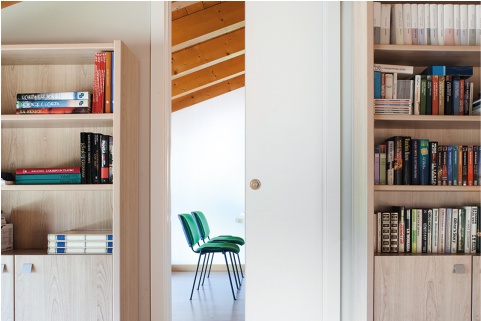Pocket doors vs traditional doors - a comparative analysis
Until you look closely, there may appear to be very little difference between pocket doors and a traditional hinged door, after all, they essentially do the same thing and look very similar too. But there are a number of subtle differences which can impact on the functionality and practicality of each type of door, and which results in one style perhaps being more suitable for your purposes than another.
Here we will take a look at these differences and at the same time weigh up the pros and cons of each type of door with an objective overview.
Space-saving
The big attraction of the pocket door is the space it creates in a room compared to a traditional hinged door. Because the pocket door opens in the same orientation into a wall cavity (the ‘pocket’) rather than into the room itself, this creates space immediately behind the door and makes this usable. In many cases this enables you to re-purpose a room or make it a multi-purpose room. With a traditional door you are limited by what you can do with a room.
Flexibility
Extra space provided by a pocket door opens up home improvement possibilities, but the pocket door also offers versatility if you have an open plan living space. This is usually on the ground floor and means you can link a living room, study, dining area and kitchen and have this space open plan when you want to. Or, using pocket doors, you can zone individual areas off whenever you want peace and quiet or privacy. Glass pocket doors also enable you to use a small space in a different way, because it allows light to shine through to make rooms more comfortable and practical.
Aesthetics
Many people comment that a pocket door is perfect for a minimalist contemporary home, because of its neat, unfussy elegance, while at the same time it is a Victorian design which has a quirky retro quality too. It is harder for traditional doors to look ‘modern’ in the same way. Also, pocket doors add to the aesthetics of the home because they enable flow and encourage movement. Traditional doors interrupt the flow of a home, while pocket doors assist in creating open spaces and enabling flow.
Installation
Undoubtedly, the traditional hinged door is easier to install, because it just needs hanging, although this does still require some skill. The pocket door is installed using a frame system which needs to be installed inside the wall cavity. This is a job that can be undertaken by a good, experienced DIY person, as it is relatively straightforward, but there is more work involved.
Door closing
Both the pocket door and the traditional door can be fitted with a door closer device to ensure the door shuts properly, although they will be different designs. With a pocket door it is true that the door doesn’t close as tightly, and there may be gaps around the edges to enable cold air and sound to travel. But this is minimal and can be managed by fitting seals around the door edges, which do an effective job in cancelling out noise and draughts.
Accessibility
The absence of a hinged connection on a pocket door means the door opening is slightly wider, when the door is fully opened. This makes a pocket door more accessible, but there are other accessibility benefits also. The basic action of opening a pocket door doesn’t require a wheelchair user or someone with limited mobility to move backwards and then forwards, they can simply manoeuvre up to the door and open and walk through it. Also, because the pocket door is hung from above, there is no floor rail which could act as a trip hazard or an obstruction to movement. Aesthetically, this also improves the look of flooring, as it is uninterrupted between rooms.
Fire safety
Both the pocket door and traditional door can be supplied as a fire door or a non-fire door as required. This includes double door configurations.
Costs
It is widely believed that pocket doors are more expensive than traditional doors, but that isn’t taking into account a number of factors which can influence cost. In some cases, a comparable pocket door may not be much different in cost to a traditional door. The size and configuration will affect the cost, as will what accessories you add and whether the door is fire-rated or not. Certainly, when a pocket door is supplied, there are no additional costs, a complete system will come with the framework required and the jambs.
So if you have decided that the advantages of the pocket door outweigh those of the traditional door, and it is the practical and aesthetic door solution for you, check out our pocket door systems online and order today.